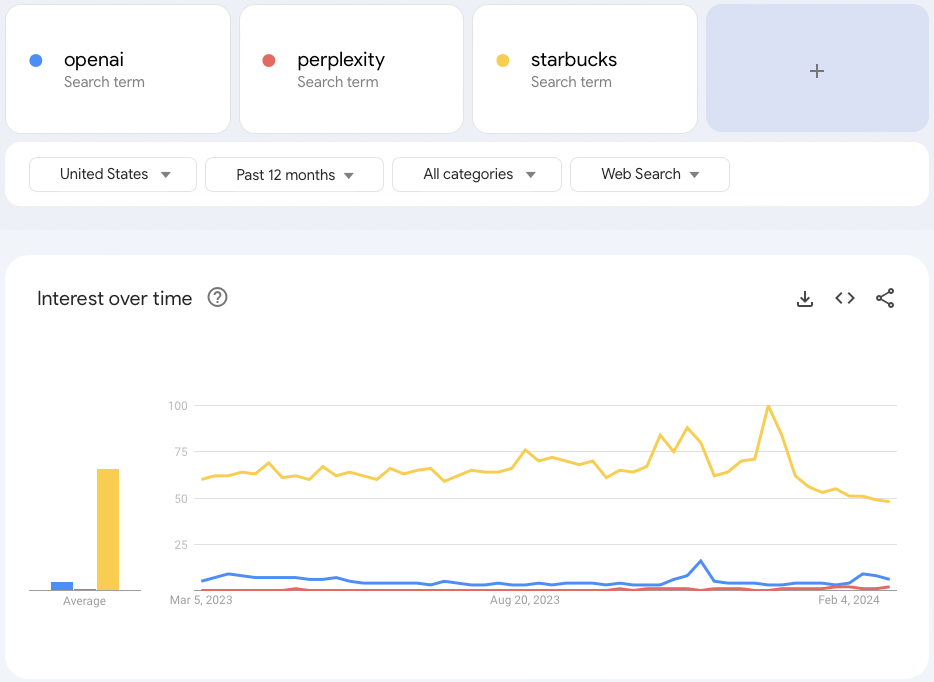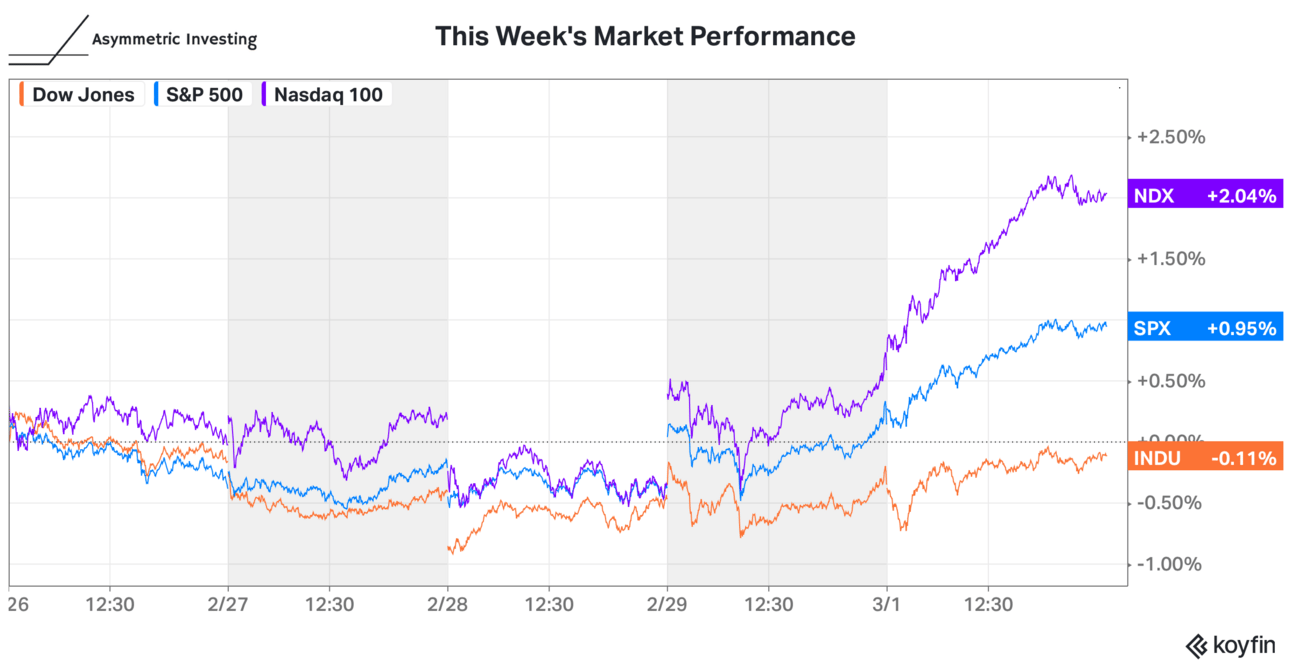I hope you had a wonderful week!
Earnings season is winding down and the mood in the market is still extremely bullish. Everything related to artificial intelligence is up big, investors are brushing off any consumer weakness or fear of rising interest rates, and for the most part strong earnings support that position. This week’s results from Target, Kroger, and Costco will give us more info about consumer sentiment.
In Case You Missed It
Here’s some of the content I put out this week. Enjoy!
What I Learned From a Stock Rising 215%: Coinbase is up big since covering it on Asymmetric Investing and I’ve learned some important lessons along the way.
What I’m Buying Today: The March 2024 buys for the Asymmetric Portfolio are out.
History Says NVIDIA’s Stock Will Fall For 1 Simple Reason: Buying stocks for 40x sales hasn’t historically ended well.
Why You Should Avoid EV Stocks: Demand exceeds supply, cash is dwindling, and in 2024 there will likely be more than one EV failure.
Disruptive vs Sustaining Innovation
One of the great debates in tech today is whether or not Google can survive — and thrive — in a world of artificial intelligence.
The introduction of Gemini 1.5 wasn’t a good look and every tech publication and podcast seems to be taking a stand on whether or not it indicates Google’s downfall.
I want to take a step back and explain why Google, in particular, is a topic of debate.
No one is questioning whether it will remain the dominant search engine. The question is whether the search engine will be relevant and profitable a decade from now.
The current theory is that artificial intelligence is so disruptive that it’ll replace traditional searches and Google won’t be able to upend its cash cow in service of building a business model that works in AI.
Disruption is usually driven by business model innovation, so Google’s inability to launch a compelling AI chatbot is the canary in the coal mine. With that context, let’s look at where Google stands.
Disruptive Innovation
According to Perplexity, disruptive innovation is defined as:
[Disruptive innovation] Introduces new technologies or business models that challenge existing offerings by creating simpler, more affordable products for underserved markets.
Gemini 1.0 says:
Disruptive innovation, on the other hand, shakes things up. It introduces something entirely new that creates a whole new market or fundamentally changes how an existing market functions. Disruptive innovations can be simpler and less expensive than existing solutions, making them appealing to new customer segments.
The hallmarks that stand out to me are:
Initially less capable than the incumbent business/technology.
Less expensive than incumbent business/technology.
Improves more rapidly than the business/technology.
Opens up new markets that previously didn’t exist.
Examples of disruptive innovation include PCs rather than mainframe computers. Despite being less powerful, the individual PC unlocked productivity solutions and Microsoft would win over the mainframe incumbent IBM.
After dominating PC chips, Intel would be disrupted by less powerful (more efficient) chips made by TSMC on the ARM architecture. TSMC’s business foundry business model enabled Apple to differentiate in smartphones, produces NVIDIA’s chips, and nearly drove Intel out of business.
Netflix is another example of disruption, beginning with Blockbuster and eventually disrupting the media business from content creators to cable TV.
Disruptive innovation is rarely invisible. In fact, it happens in the light of day with the target of disruption either ignoring the disruption or being unable to make the business model or technology shifts successfully.
To judge the level of disruption, I try to think of why the incumbent is structurally unable to respond to the disruption taking place in front of their face.
Sustaining Innovation
More common is sustaining innovation or an innovation that makes the incumbent stronger. According to Perplexity, sustaining innovation is defined as:
Involves improving existing products for current customers, aiming to enhance quality and performance.
Gemini 1.0 says:
Sustaining innovation is all about making existing products and services better. This could involve incremental improvements in features, performance, or efficiency. Think of the annual upgrade cycle for smartphones - each year's model is a bit faster, has a better camera, or some other improvement.
The hallmarks that stand out to me are:
Incumbents are well suited to incorporate the innovation in their business/technology.
Happens gradually.
Incumbents can incorporate the business/technology before a disruptor can reach scale.
The core business model doesn’t need to be sacrificed in service of chasing disruption.
Sustaining innovation is the innovation we expect to see in business every day. Smartphones get faster, cellular connections get faster, video is higher resolution, games are better, etc.
These are innovations, but they happen almost without us knowing or appreciating them. And they help drive the incumbent’s business forward.
Is AI Disruptive or Sustaining?
This is the trillion-dollar question today. There’s no clear answer, but I think we’re starting to answer some of the questions above.
Is AI disruptive to Google? Here are the cases for disruption ✅ and against Google’s disruption ❌ .
AI has started as less capable than traditional search. ✅
AI is improving rapidly. ✅
AI search/inference is much more expensive (~10-100x) than traditional search. ❌
AI doesn’t create a new market, at least not yet. ❌
AI doesn’t have a real business model yet.
Ad-supported AI assistants are a logical business model and Google has a huge advantage in advertising. ❌
AI is already being rolled out gradually in Google’s existing products, leveraging billions of users before competitors reach scale. ❌
After spending 25 years optimizing search result speed, Google has a massive infrastructure advantage. This has already led to Gemini being faster and more capable in many ways than competitors. ❌
Google has the best infrastructure, some of the best AI models in the world, multiple products with over 1 billion users, and it has the advertising backbone that will likely drive AI monetization.
Tech may be in a fervor over artificial intelligence is at a peak because everyone in Silicon Valley is building something AI-related, hoping to disrupt Google. The reality on the ground is that most people don’t care, yet.
The average person is more interested in getting a cup of coffee than they are in trying the newest AI tool. And, according to Google Keywords, interest in AI drops off a cliff once you get out of tech hubs like California and New York.

Is artificial intelligence innovation? Absolutely!
Is it disruptive to Google’s search business?
The jury is still out, but the evidence points to this being a sustaining innovation more than a disruptive one.
That said, Google needs to get its act together from a product standpoint and I wouldn’t be surprised to see a management shakeup in the next 6 months. Time is of the essence or this will be a disruption to one of the most powerful companies in the world today.
You can get all Asymmetric Investing content, including deep dives, stock trades before they’re made, and ongoing coverage of Asymmetric Universe stocks like Airbnb with a premium membership.
All for only $100 per year.
Disclaimer: Asymmetric Investing provides analysis and research but DOES NOT provide individual financial advice. Travis Hoium may have a position in some of the stocks mentioned. All content is for informational purposes only. Asymmetric Investing is not a registered investment, legal, or tax advisor or a broker/dealer. Trading any asset involves risk and could result in significant capital losses. Please, do your own research before acquiring stocks.


